I musta missed sumthin somewhere, those number put me off the coast of Anartica…(http://www.largescalecentral.com/externals/tinymce/plugins/emoticons/img/smiley-wink.gif)
You did something wrong… it put me just southwest of Telluride CO on the side of what appears to be a rock slide above the river.
I see the grade David where is the remains in relation to that slide?
That grade is cool right under the cliffs looks more like a mountain goat trail.
Evidently. I did it a couple of times and it went to the same place.
The recovery mission is very cool. How do you know the parts are still there 90+ years later? Or is part of the mission to discover if they are?
Ken Brunt said:
Evidently. I did it a couple of times and it went to the same place.
Ya gots to put it in like this: 37° 52’ 32.47N 107° 53’ 59.47W
You have to wade the San Miguel? I’ve fished that river farther north. I hope the water is low for you!
Has anybody located the parts or do you have to move talus?
Use the Daktah’s co ordinates, I used google maps and the switched to earth view. Copy n paste did it.
John
Yep copy paste worked in Google earth. I used David’s but omitted the deg part.
Made it home and got some pics downloaded.
The object of out quest:
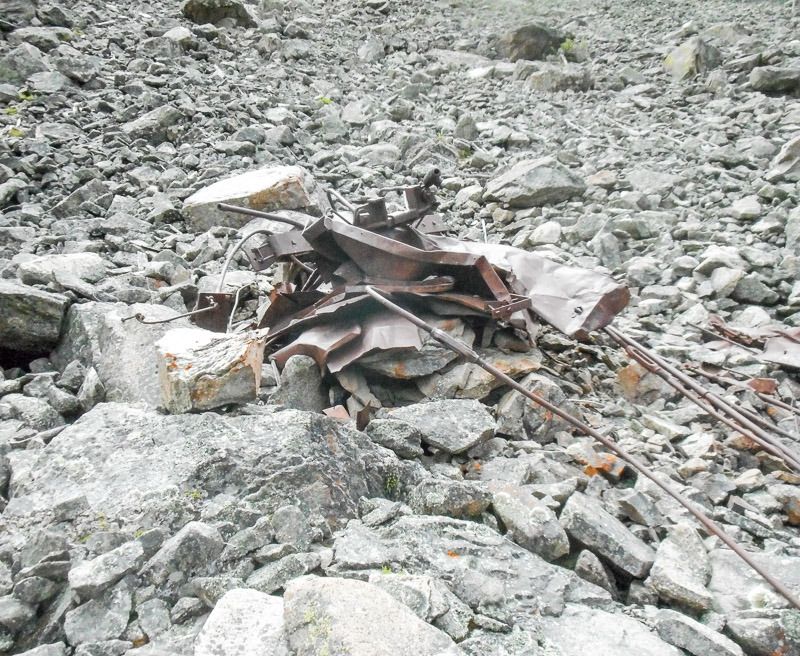
1st off. Unsuccessful day… I’ll try to fill you all in as I post todays story.
The Google Earth’s geo code should have placed you, (Drum roll for Devon) about 10 miles south of Telluride, and north of Ames CO. Yes it is on a very steep rock slide area, which is actually a snow avalanche slide area. It was an avalanche that originally sweep the cars off of the Rails. This location is close to Ames, but it is not the noted “Ames Slide” that the RGS is known for, that is located about 1/2 mile north of this snow slide area, much closer to the location of the Ames water tank.
Some of the time that I have been missing from this site has been pursuing this bolster and parts. In 1923 reefer D&RGW #79, one of the original 50 that were made in 1908, was sweep over the side with a 3000 series boxcar. This was the first reefer of this series to be scratched off the list, and because it went over in 1923, it was still all original, all the rest of the reefers went thru an up-grade re-build in 1926. Because this is an original, and our restoration of #39 has no bolsters or trucks, we need to have an original set. All of the other “shorty” 30ft reefers, at C&TS and the Colorado Railroad Museum (Golden) are post 1926 rebuilds, they all have different bolsters and trucks. We were alerted to the possibility that some of the parts to 79, may be still on the mountain side earlier this year. A very early attempt to locate the parts was thwarted by snows, and the very remoteness of the site. This remoteness and the rugged terrain to get to the wreckage and the fact that the RGS did not report the loss in an avalanche of two cars, has been a good thing to preserve what is still there, and protected the site from RGS scavengers. We decided early on to play this very close to our vest, to keep the location a secret, to prevent looting, until we could secure permission from the Forest Service to get what we needed for our restoration. We know that the site was looted at least twice in the late 50’s and early 60’s, removing some of the box car pieces and etc. The RGS had salvaged the wrecks in early 1924, so some of the missing pieces may have been removed by the railroad. An attempt to locate the wreckage by aerial photos proved unless. In early spring two of us went on a field trip to try and locate the wreckage from the ground. Another trip to the slide area and a very arduous foot search down the mountain side and then back up to the ROW was successful to locating the reefer remains, we confirmed that it was the correct car by certain pieces that we located that were unique to that reefer series. Another trip to the wreck site attempting to secure a “easier” way in and off the mountain was un-successful, and the plan we put into effect today was played out and approved by the Forest service. In a nut shell, a whole lot of hours and effort was expelled behind the scenes. BTW: I so wanted to pass on to you guys what we were up to for this summer, but I didn’t want to spill the beans.
The remains of D&RGW Reefer 79.
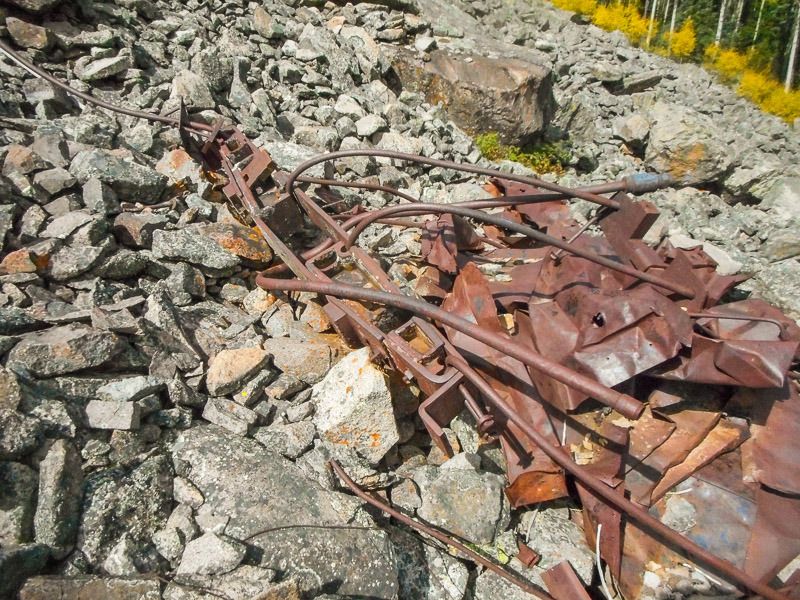
How do we positively ID this twisted mess as being of #79?
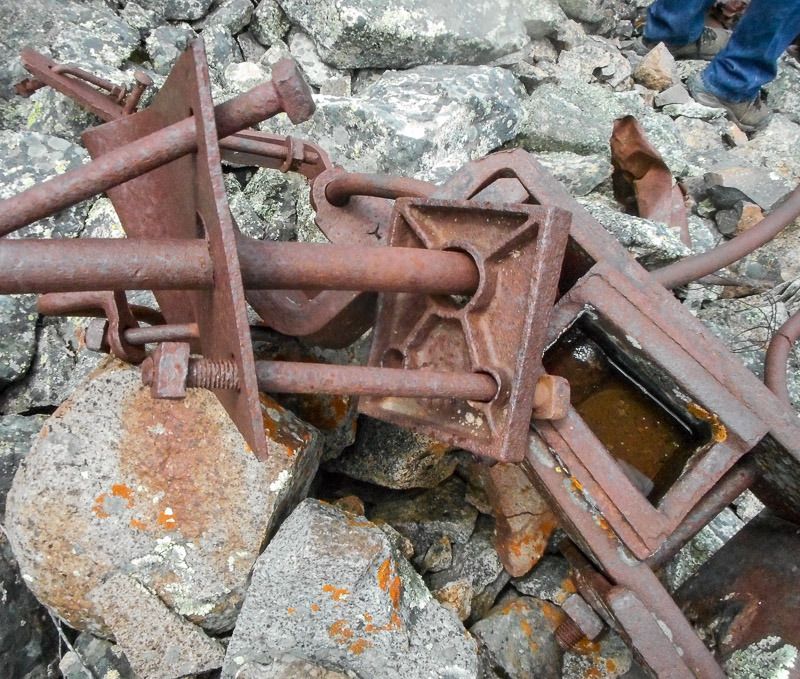
This square casting, with a truss rod running thru it, and still attached to the lower corner brace, with a grab iron and a stirrup still attached, is unique to the construction of these reefers. The truss rod had no big washer under the end bolt that went thru the end sill, but the lower corner brace worked as a "washer under the nut, and this cast block was behind the corner brace, and notched into the end sill, with the molded in ridges pressing into the end sill. Unique only to these reefers. And it is still attached to its component pieces.
Today: The land on the East side of the San Miguel River belongs to the Nature Conservancy, and so being off limits to all mechanized travel, We had to pack in all our gear about 1/3 mile from the trail head. We set up base camp on the East side of the river. And started the process of getting to Camp “Bravo” On the West side of the river. A guide/safety rope was strung across the river, and a pulley bucket was strung across to ferry equipment across.
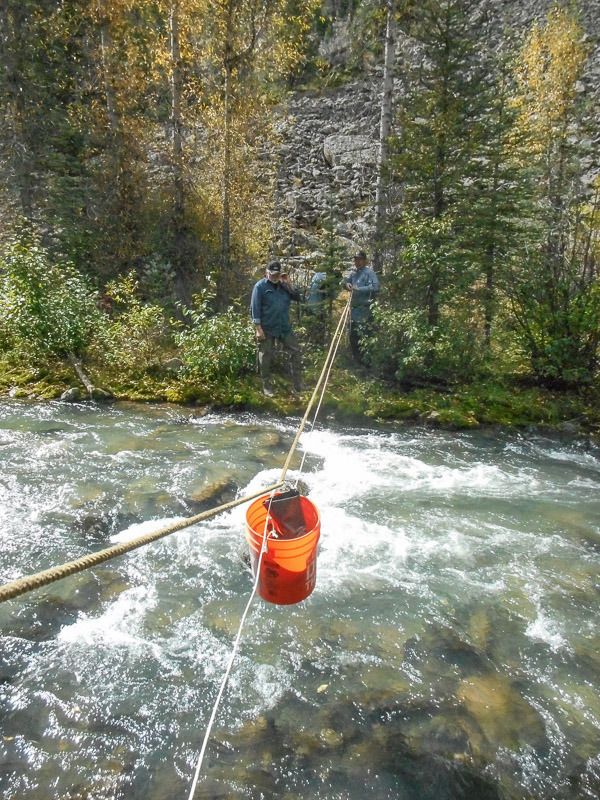
To get the needed parts down off the mountain, we would need to use a cutting torch to get the bolster apart. In tact the bolster assembly weights about 550 lbs., totally unmanageable and heavy enough to kill in an accident. We needed to hump uphill to the site, a cutting torch, two small bottles of Oxygen, and a small tank of acetylene gas, regulators, hoses, goggles, striker, leathers and all that stuff. Plus assorted tools, hammers and etc. And lunch, water, and cookies. Can you say sherpa?
Here is what were after:
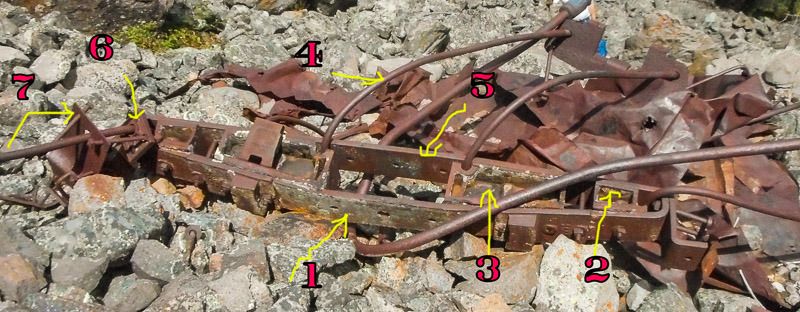
#1 Bottom bolster plate. Steel - 1" thick, about 9" wide, and about 8 Ft. long. Unique to this style bolster. We want to use this one, and make a pattern for the other one on our car. Est. to be about 125 lbs. This will be the gorilla to get off the mountain. It is steel, and we probably can’t hurt it to much dragging it down the hill.
#2 Outside spacer. Fits between the upper and lower bolster bars. Again Unique to this bolster. We will measure and use this piece to make molds for casting new replacements. Cast iron, about 20 lbs.
#3 Inside spacer. Fits between the upper and lower bolster bars. Again Unique to this bolster. We will measure and use this piece to make molds for casting new replacements. Cast iron, about 35 lbs.
#4 This is one of the center truss rods. It runs thru the bolster, and you can follow it out to the coupler pocket, which is still attached. We will leave this behind. It’s 1 1/8 thick for most of the length, but at the ends it is 1 3/8 thick at the end threads. Bent like a pretzel.
#5 Top bolster plate. Very common, nothing unusual about this piece, staying on the mountain.
#6 That unique truss rod casting.
#7 The lower corner brace with attached pieces.
The #1, #2 and #3s are our primary goals. Other pieces that we can reasonably salvage and get off the mountain come next on our want list.
The salvage site:
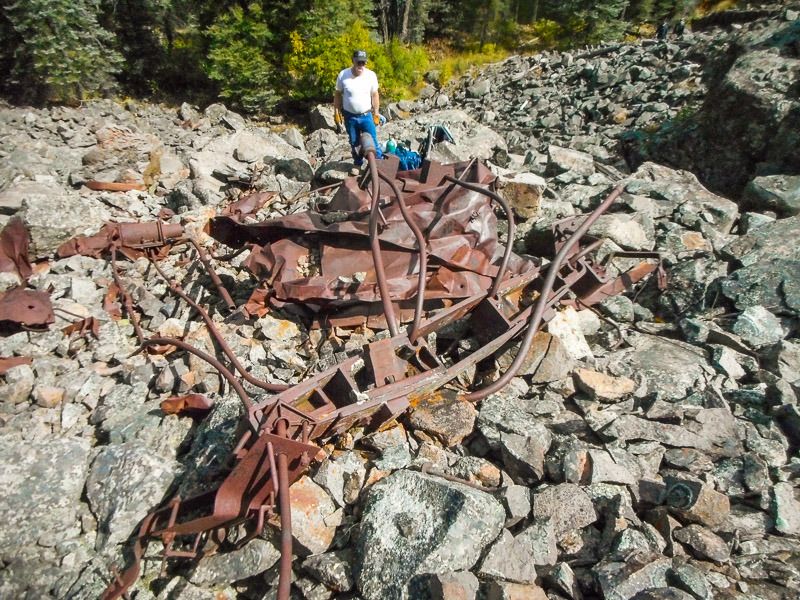
Looking down to the wreck site from about 1/2 down the mountain.
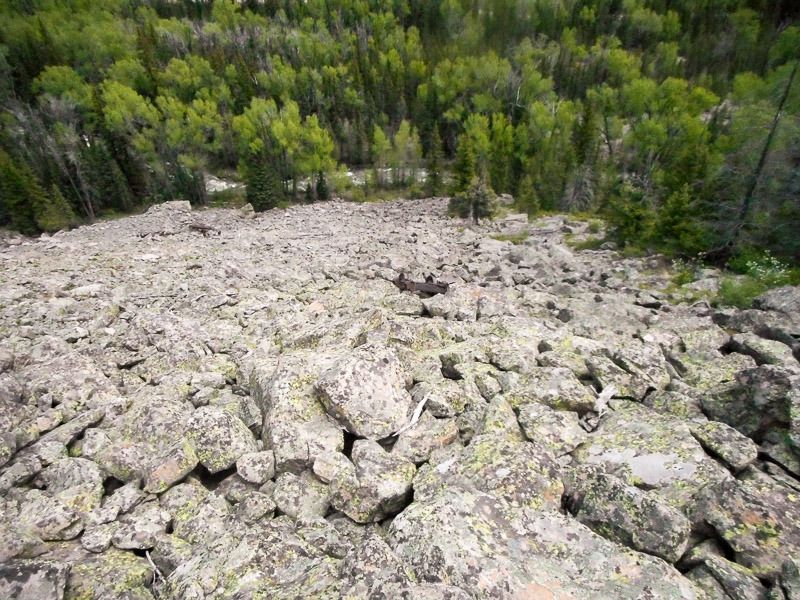
And the down hill side to the river.
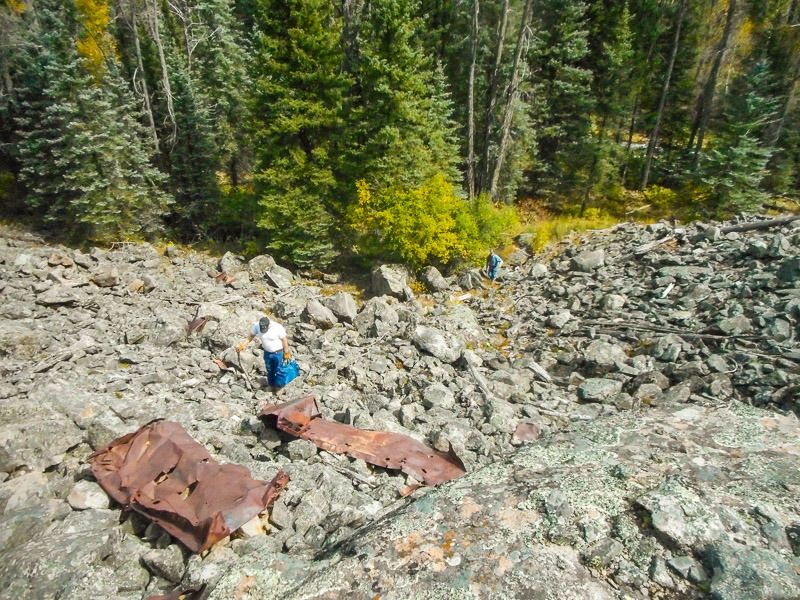
It was a beautiful day in the San Juan’s for a hike. So beautiful that we thought that we should do it again tomorrow. Which we will do. Why?
Well,… After humping all that gear to the wreck site, we had a problem with the acetylene gas bottle, and nary a torch was lit. Big bummer. The car has been setting there for 93 years, so one more day won’t matter.
More tomorrow.
Daktah John said:
Ken Brunt said:
Evidently. I did it a couple of times and it went to the same place.
Ya gots to put it in like this: 37° 52’ 32.47N 107° 53’ 59.47W
That’s what I eventually did. I also had a pretty good idea of where the location was from the description. There were numerous rock slides on that portion of the RR.
Thanks Dave. I love historical archaeology! Good luck. (http://largescalecentral.com/externals/tinymce/plugins/emoticons/img/smiley-wink.gif)
Very Cool, Thanks!
SUCCESS ! ! ! We got the main parts off the mountain… WOW am I dead tired… I haven’t done this to my old body in many years…
Boy did we underestimate the weight of the cast iron pieces… Humping them off the mountain was brutal.
I’ll get some pics posted tomorrow and fill ya in on the adventure. Now time for hot bath and Sleeeeep.
Dave,
I’m glad you kept everything a secret until now. Your story reminds me of the Wellington, WA avalanche. 15-20 years ago the site of the wreck was inaccessible, and just the local railfans knew about it. Lots of steel in the valley, and railfans respected it as the memorial to the 96 people that perished. In the last 10 years, the avalanche has been a subject of a popular ‘historical’ novel, written by a non-railfan, and the site has undergone a lot of trail improvements (really nice trail now). However, the downside is that each year more and more pieces go missing, and I feel that the site is losing its historical impact. I’m glad that the Forest Service allowed you guys to remove the ‘remains’ in a meaningful and respectful why that contributes to a larger historical knowledge. Granted, it’s not the site of 96 people’s death, but your group shows the positive message of historical preservation.
Dave,
I too am glad you found it. It is tempting to want to “collect” it for yourself but why not collect it for all to enjoy. I have been made aware of the pedistals and maybe an entire truck of the CR&N coaches but the guy is being difficult. While I would like to add it to my collection the proper place would be a permant display in a museum for all to enjoy.
So hats off to your team and I look forward to maybe one day seeing itnin person. Thanks of r your hard work in recovering a historical artifact.
New name for you Colorado David. Do you have a whip and cool hat???
Great Work Dave . . . ! Thanks for posting all about it.
Boy my body is unhappy with me… Getting old su(#s… But did I mention that it was a beautiful day in the Rockies.
Fall colors were about at there peak at the 8500 ft level where we were:
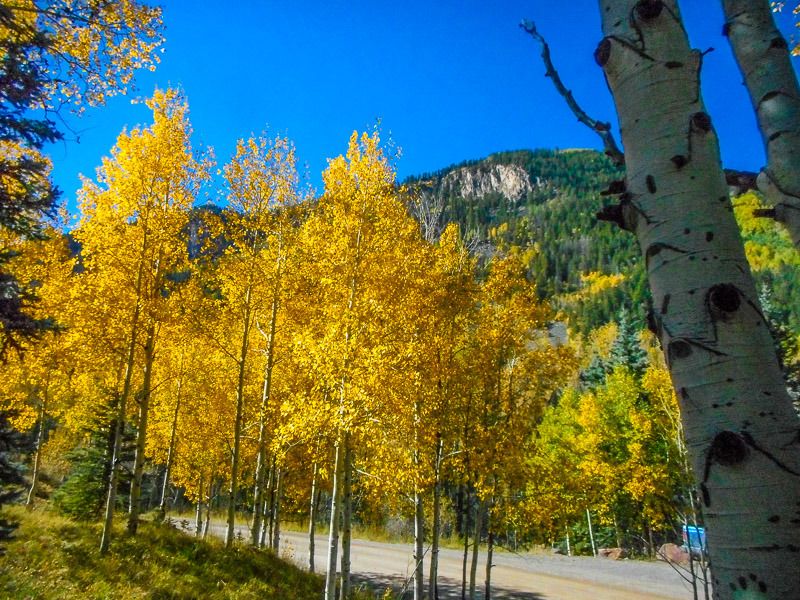
More to edit thru.
Beautiful
Thursday’s problems with the acetylene bottle really put a crimp in the grand plans for the day. We had a crew of 6 DRHS guys and the 1 Forest service rep. On the mountain, and two guys at the base camp on the Eastern side of the river. With leaving the torch stuff on the mountain for the night, made it easier on Thursday when we did the re-play. But we only had 3 of our guys and the Forest Service guy on the mountain. Basically doubling the load factor to get the heavy stuff off the mountain.
NOW, I would like to take the time to comment on our US Forrest Service representative that made this all possible. Brian Hass is the regional Forest Service archeologist. Brian was the guy that had to push the paperwork thru and clear the way for us to get the parts. Brian was not at all what we expected from the Forest service, but he is just a great guy that showed up on time, and ready to help, not just to watch, to work, help. He grabbed as much gear as he could and humped it down to the river, returning back up, and hauling more down to the base camp. He hauled as much gear down as any one else on the team. A real asset to getting things done. His rope skills were used to rig up the traveling haul bucket across the river. He also back packed his own stuff across the river, along with our stuff. He jumped in and grabbed the stuff to go up the mountain, and made a couple of trips up, hauling our stuff. On Thursday’s re-run he was glad to be there, and again eagerly helped where ever he could, especially with our short staff. This young man was a credit to the US Forest Service, and distinguished himself as a great individual. The government services could sure use more like Brian.
Back to the task at hand. Gene Lincoln put his cutting torch skills to work freeing up the bolster from the tangled truss rods, and then cutting the very rusted thru bolts off so we could separate the parts. I wheeled a heavy hammer to persuade them to separate after 107 years together.
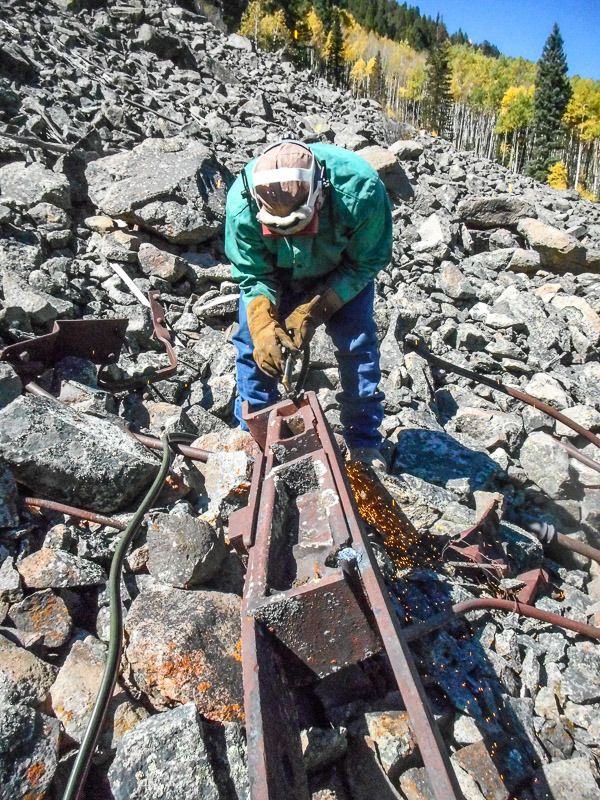
Now the brute force came to play. Thump, Bang, Bang… as I drove the bolts out.
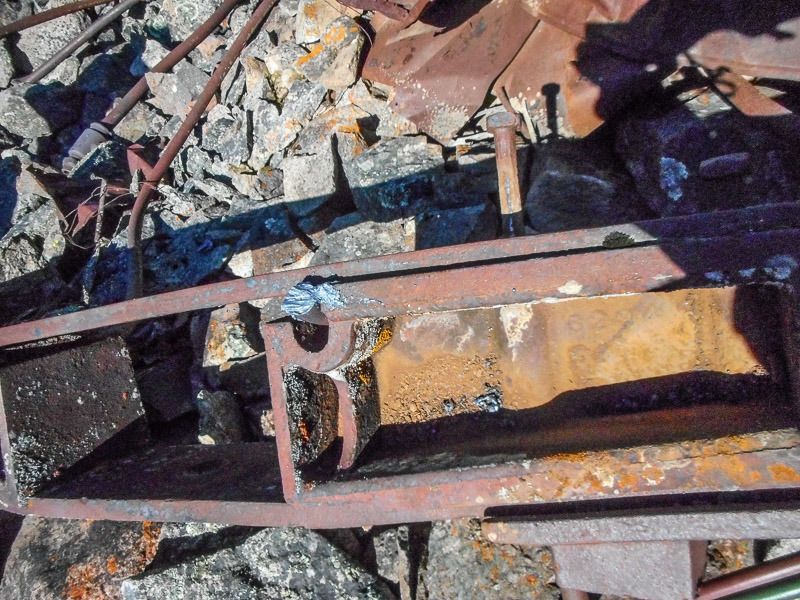
And the first part off, and one of the “Keepers” was the pivot block plate. This is the part that as the truck turns and pivots, it rubs against and prevents the car from tipping from side to side. There are two of them, one on each side of the bolster, and they mate up with the truck. NOTE: the bolster has been flipped upside down in this picture.
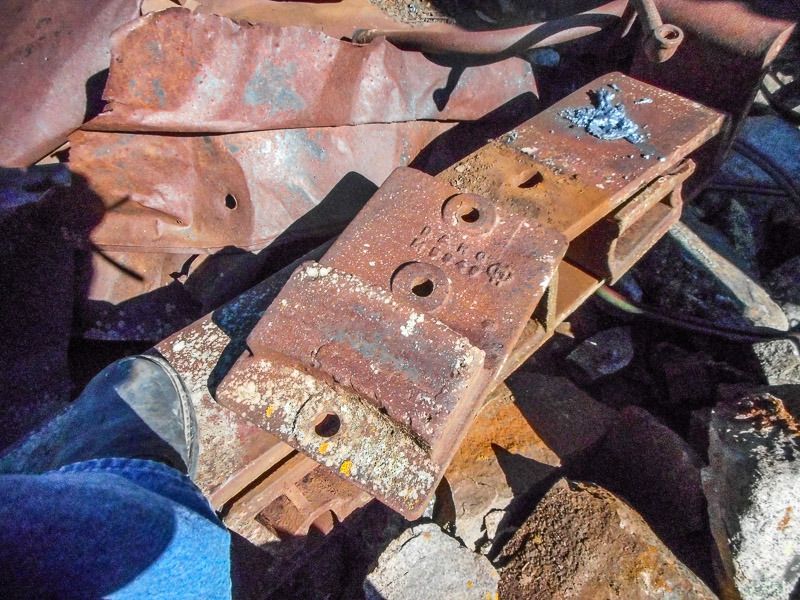
Also note that the casting has “D&RG” on it. Making it a pre merger part. After the merger it would have been cast with D&RGW
After we got the pivot block off, we noted that the thru connecting bolt holes had been drilled twice, elongating the holes. We deduced that it must have been done intentionally, as that if it was just something not fitting during field assembly, they (the workers) would probably have used a cutting torch to oversize the hole. Remember that this is 1 inch thick steel.
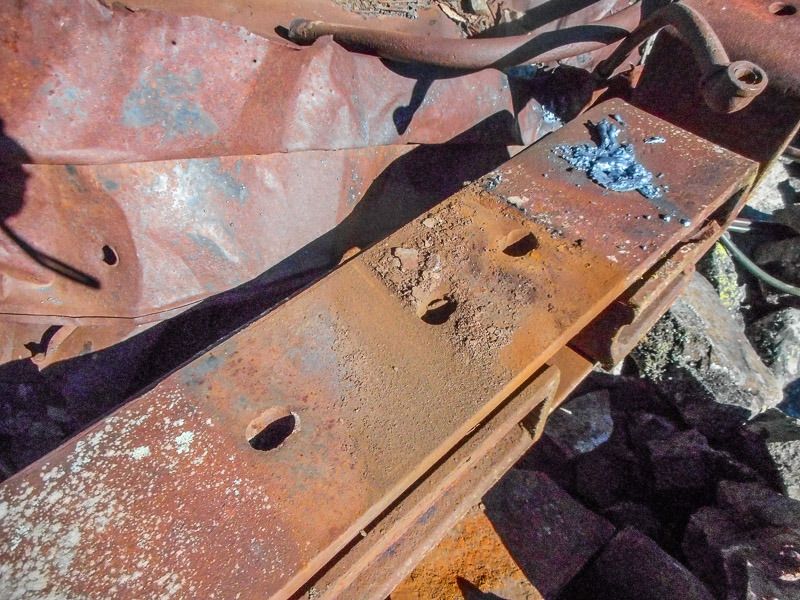
Yet another little mystery that we run into as we deal with the restoration on this old stuff. Was this a one off, or were all of them drilled this way? And if so, Why? For what reason? If anyone knows, Please let us in on the secret, of why?
And the other side. Double drilled also. Much to our chrigrin, these weighed about 15# each. Yet another part to hump off the mountain, over the river, thru the woods, and up to the road.
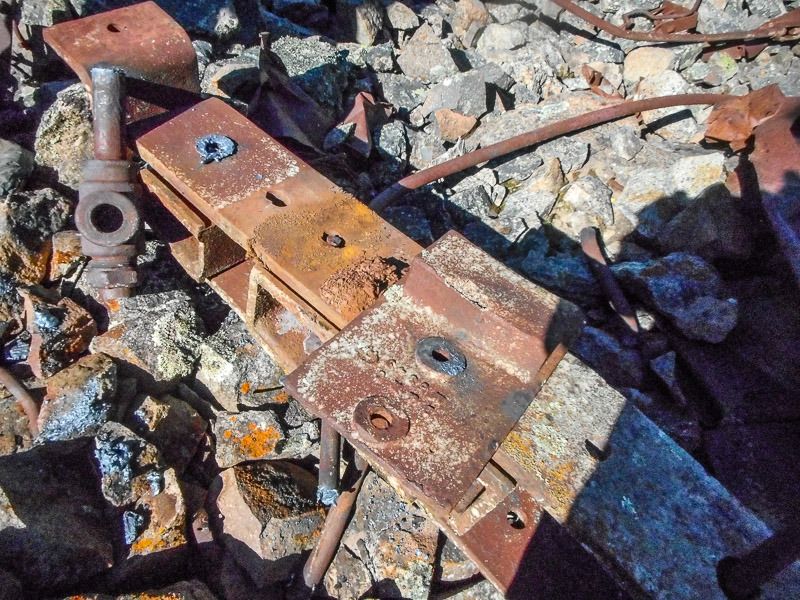
Yes, we have separation. The BFH did its job. With the top plate loose, the outer and the inner spacers came out.
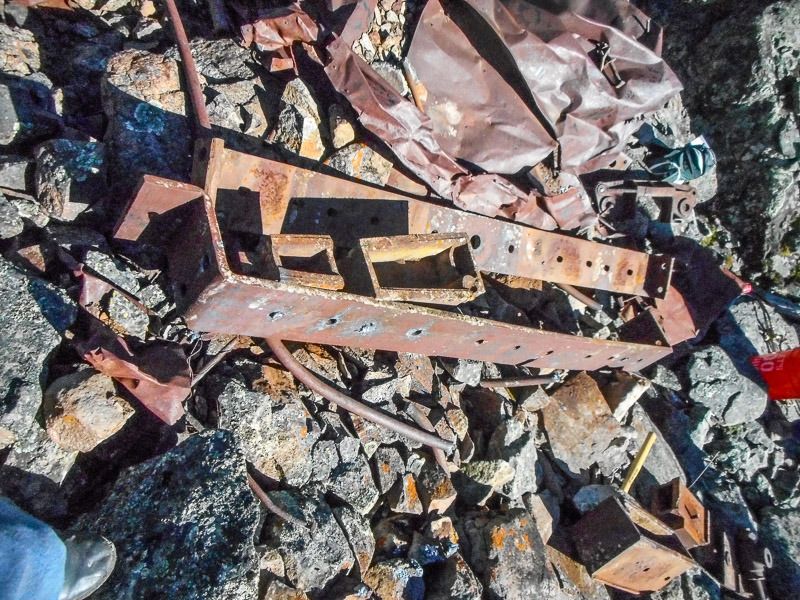
We really miss judged the weight on these pieces! Or Maybe if the team leader had told us the truth we wouldn’t have showed up. The outer (smaller) spacers weighed about 40 lbs. each. And the inner (bigger) ones came in at a whooping 80 lbs. apiece. All of this has to be hand carried down the rocky slope. They are cast iron, so care had to be taken not to drop them and break them. Brian (US Forrest Service) emptied his back pack, Put one in and very carefully humped it down the mountain. Thats an 80# pack on his back… Mine wouldn’t fit in my pack, so I hand carried it to the bottom. Brutal…
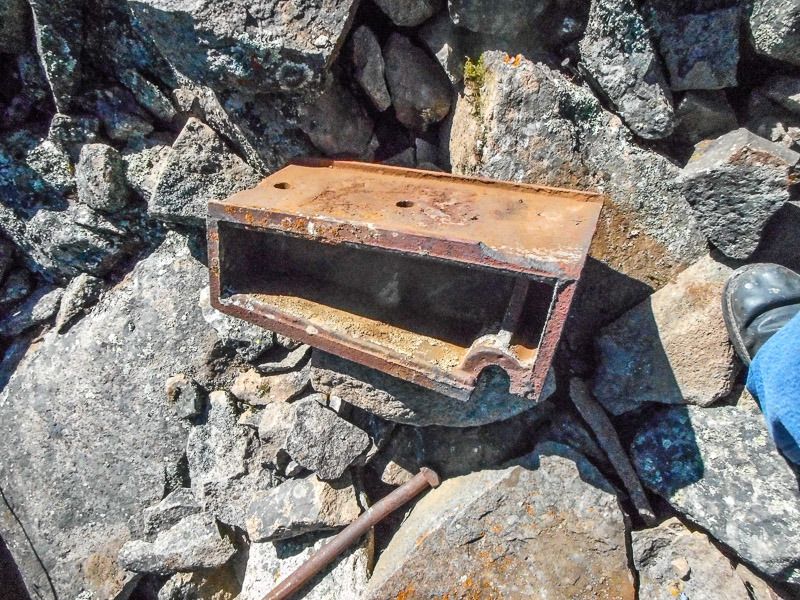
We took a well earned rest and then went back up the mountain and each back packed down the small spacers.
Did I mention that despite the work it was a beautiful fall day in the San Juan’s! Looking south towards Rico.

Getting the Bolster Plate (#1 in the earlier diagram) off the mountain was really, really hard, tiring, and dangerous work. I was the most nimble of our crew, took the point on sliding the beast down the mountain. We used gravity to our advantage when we could. A stout rope was tied to one end, to try and control the rate of decent. And I would lift the end over the next rock, and we would let it slid on down to the next rock, and start over again. BTW: thats our Forrest service pal Brian on the top end of the rope. It took the better part of an exhausting hour for Brian and I to get it to the bottom. No dammage to Brian, Myself or the bolster.
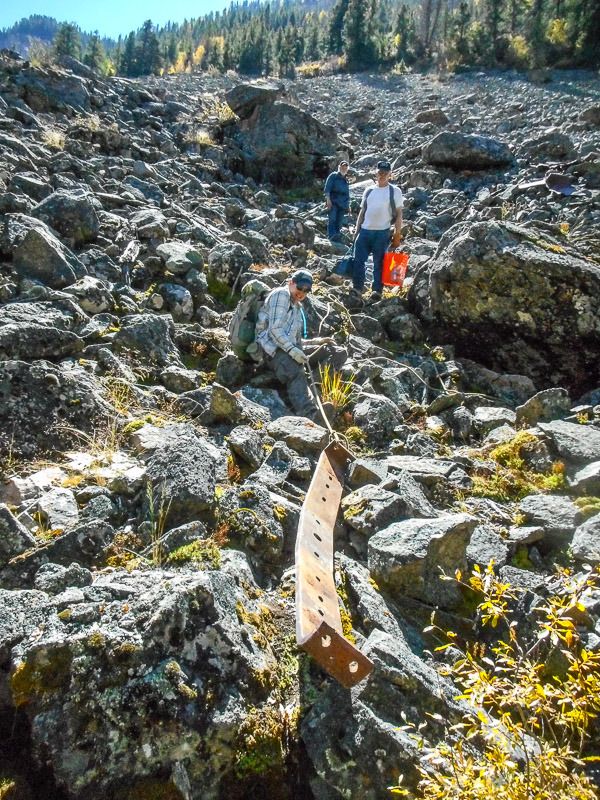
That monster is about 225 lbs. of steel. After getting it to the bottom and to the river edge. We (Brian and I) made several more trips up the mountain to bring down all the torch stuff and smaller pieces.
The wreck site as we left it.

We drug the heavy stuff back across the river, Bucketed the lighter stuff, and finally dragged our tired but back across. Brian grabbed one of those 80# monsters, put it in his backpack, and humped it up to the road, I got the two small pieces to the road. Brian made three trips to the road and back with gear. Brian, myself and Gene tied a rope to the beast and drug it thru the woods and up to the road like a team of mules. We were done, physically, exhausted. But we have a tail of a great RR adventure to tell our grand kids.
The beast.
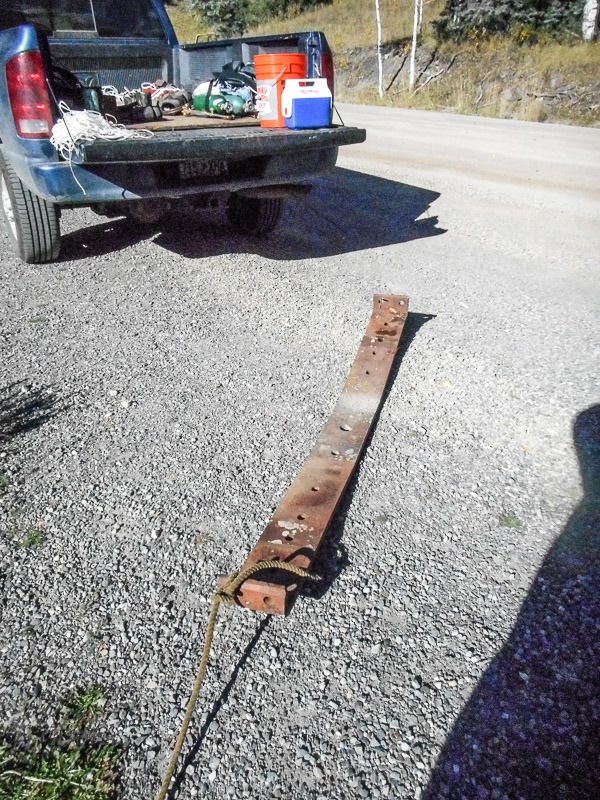
More follow up to come.
My hat’s off to you guys. Must be very satisfying finding so called “junk” and turning it back into something useful to be enjoyed by future generations of RR buffs.
Excellent narrative on this “Restoration Against All Odds” adventure. What a tremendous effort by a group of dedicated narrow gauge historians! Very interesting story about how the parts managed to remain on the mountain and the history of why the parts were so important to salvage. Thanks for sharing!